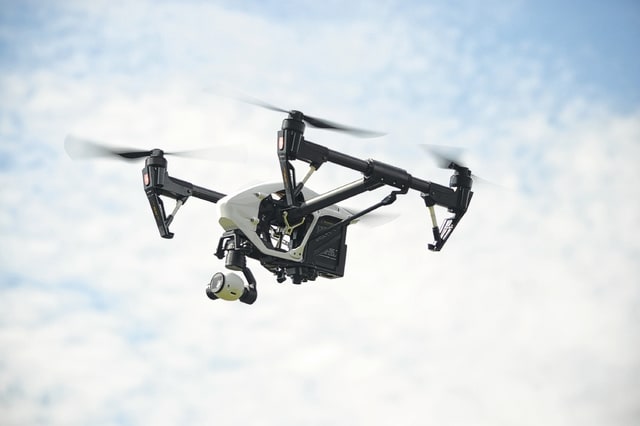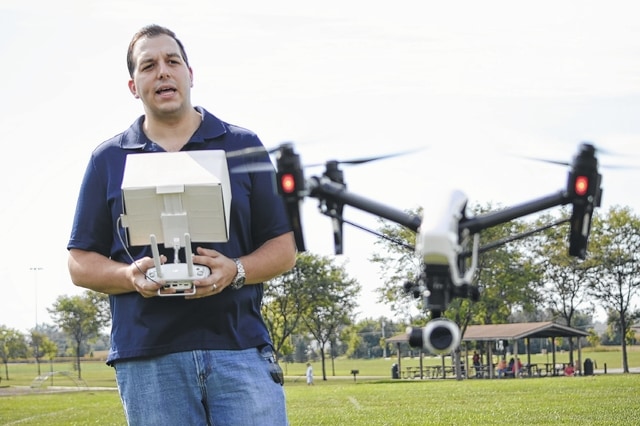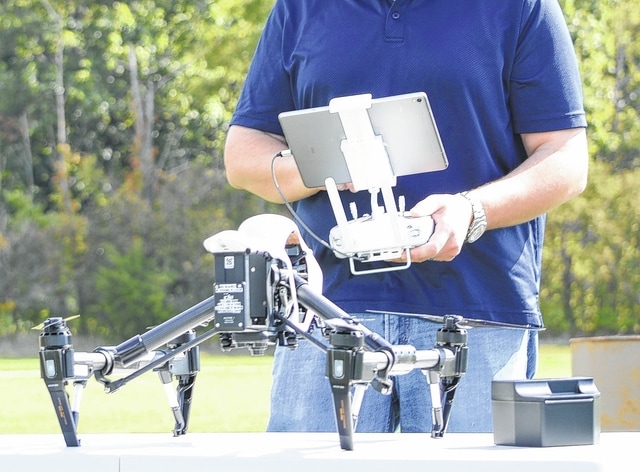


Chris Smith had set up his folding table at an open field in Smith Park on a sunny, windy day in September.
A large black case next to the table contains his DGI Inspire 1 with its remote control system. The nearly 6 1/2-pound drone is about 1 1/2 feet long and wide and a foot tall with a white-colored body, four black propellers and a camera attached at the bottom.
The Delaware resident placed the drone carefully on the table but he doesn’t send it into the air right away like the typical eager and impatient child. Smith silently carried out his pre-flight check list for the unmanned aircraft system and the remote.
“One little thing can make the drone crash,” he said as user-error is the culprit of drones that fall from the sky nine out of ten times.
At take off, the drone emits a humming noise as the four propellers rise gracefully above its body. While Smith remotely moves the drone, he can watch a video on a tablet, connected to the controls of the remote, transmitted from the drone’s camera.
He flew the drone across Troy Road toward a wooded area before it was out of sight, the humming gone, for The Gazette reporter witnessing the display.
“The technology has come a long way,” Smith said, and who’s been flying drones for about five years and has owned about 12 during that period.
“It’s an addiction,” he said.
Smith carries a permit to fly the system commercially. Since September 2014, the U.S. Federal Aviation Administration has granted more than 5,550 exemptions permitted from Section 333 of of the FAA Modernization and Reform Act of 2012, according to an FAA spokesperson. In prior years, drone operators had to meet the same requirements as airplane pilots.
The exemption process was extensive enough to have applicants hire attorneys for thousands of dollars without any guarantees.
Smith, an information technology professional, got clever and used previous submissions as the template for his application. He received his exemption in April after about a nine-month waiting period.
Smith now offers photography and cinematography services through his business, Drone Views Ohio, and has worked at weddings and for farmers that need an aerial view for their crop reports.
New rules, gray areas
In late August, the FAA had released a set of new rules, formally known as Part 107, for commercial drone operators,
“People are captivated by the limitless possibilities unmanned aircraft offer, and they are already creating business opportunities in this exciting new field,” said Anthony Foxx, secretary of U.S. Department of Transportation, in a statement. “These new rules are our latest step toward transforming aviation and society with this technology in very profound ways.”
Under the new rules, drones must weigh less than 55 pounds; must fly within a maximum altitude of 400 feet from its take-off position; and within the operator’s visual line-of-sight during only daylight hours. Drones cannot without approval fly over people and within five miles of an airport, if it has an air traffic control tower. The FAA requires commercial drone operators to have a remote pilot license by passing an initial aeronautical knowledge test.
For hobbyists who want to fly for recreational purposes must register their drones with the FAA, according to its website. Hobbyists can fly in accordance with the special rule for model aircrafts or follow the Part 107 rules.
As of mid-September, more than 10,000 remote pilot certificates have been issued, according to the FAA.
But Smith said there are still gray areas that need to be addressed.
“While the rules are great, there is no enforcement,” of FAA regulations, he said.
Local police cannot enforce FAA rules unless the drone is used to break municipal or state laws, Smith said. In one example he provided, police can have operators accountable if they used drones to look through someone’s window, which is no different if they used a regular camera.
“Anybody can buy a drone and fly it in the air within minutes,” he said. “That’s the scariest thing.”
Delaware police Capt. Adam Moore said his department has addressed three drone-related calls since 2010. A homeowner notified police that a drone was in his backyard in 2014 and in the following year residents of an apartment complex called out of fear that a drone was spying on them. In June, police were called as juveniles played with a drone at an apartment complex’s parking lot, hitting vehicles unintentionally as it came crashing down.
Moore said he expects the issue to increase as the drone popularity rises, but said local law enforcement wants drone operators to display responsible behavior and respect the rights of others.
While legislating responsible behavior is difficult, “some guidelines and resources would help us out,” he said.
Legislation considered
Two bills were introduced in May 2015 at the Ohio House of Representatives regarding the use of drones. State Rep. Bob Cupp, R-4th, introduced a bill that would make it unlawful to use a drone to commit a crime, but does not address non-criminal issues such as permitting requirements, use in law enforcement activities, non-criminal flying restrictions or whether pre-authorization is required to fly the drone.
“With the increase in the availability of drones of all sizes and capabilities – including the ability of drones to photograph, video record, shoot projectiles, and reach places where an innocent person would otherwise be out of harm’s way – this bill seeks to pre-emptively get ahead of a new wave of criminal conduct that utilizes drone technology,” he said in a statement.
State Rep. John Barnes Jr., D-12th, introduced a bill that would regulate the use of drones near airports and impose record-keeping requirements on retail sellers of drones. Drones could not operate within five, three or two miles of an airport, depending on whether it has a published instrument flight procedure and operational tower. The Delaware Municipal Airport on Pittsburgh Drive does not have a control tower.
Both bills were referred to a committee shortly after its introductions but, since then, there has been no movement.
The public can report violations of drone-related federal regulations to the FAA but it may be ineffective, Smith said. Half of the people he has drone-related discussions with, are afraid of the technology. The big thing is to educate operators and the public, he said.
“The drones are here to stay,” Smith said. “It’s the way of the future.”




